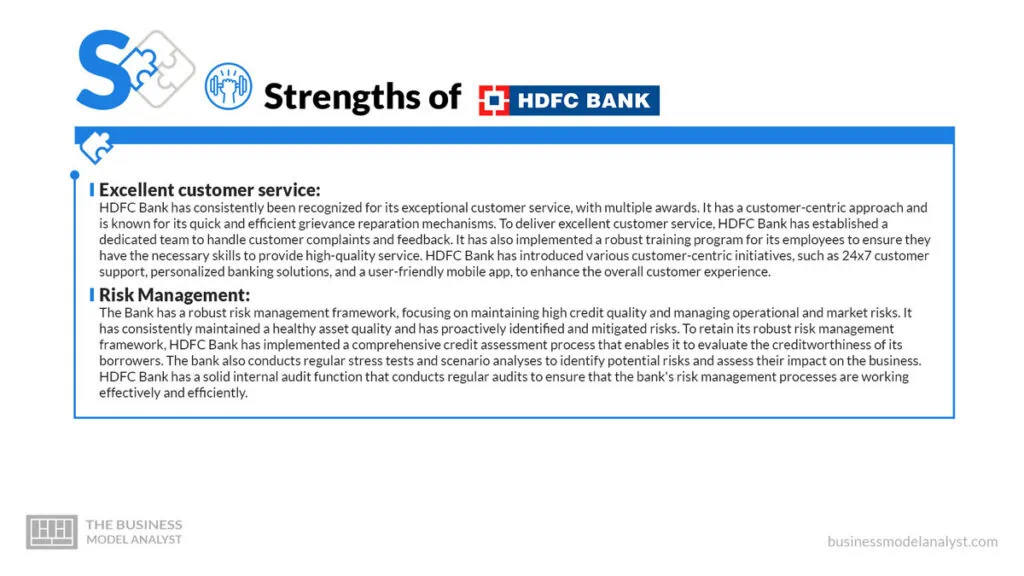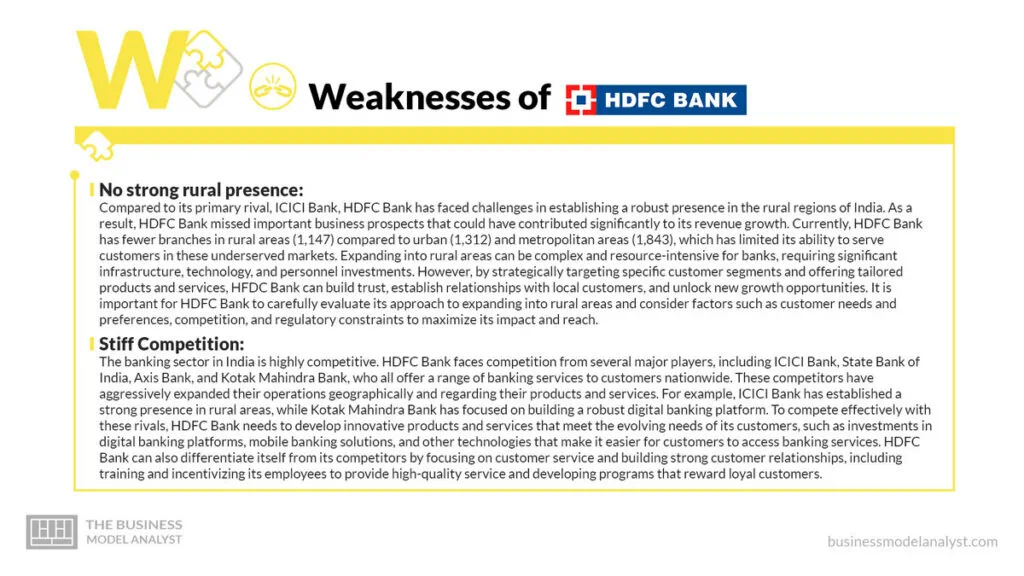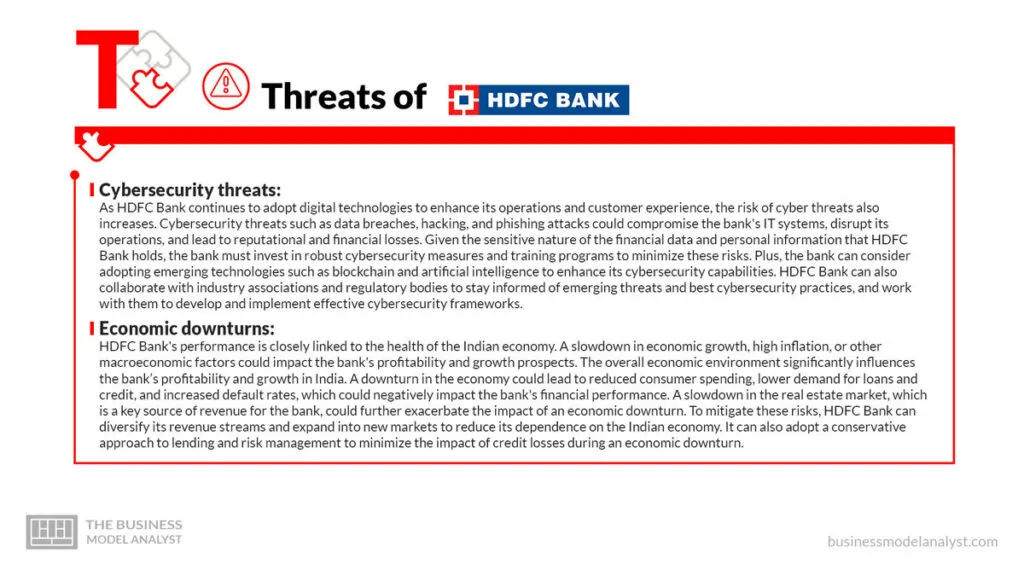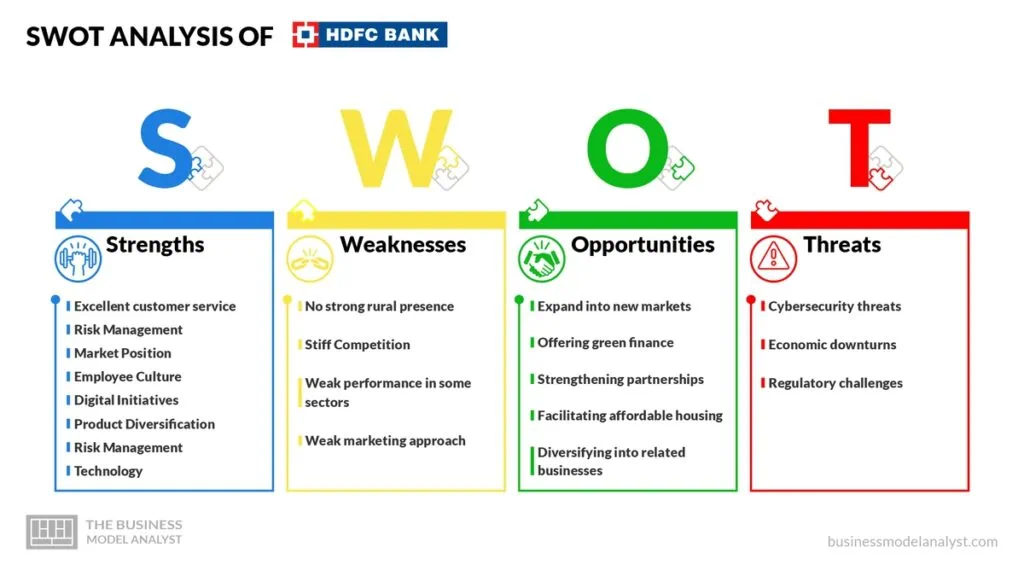HDFC Bank, headquartered in Mumbai, India, is a leading private sector bank that provides a wide range of financial products and services. The bank was founded in August 1994 by Housing Development Finance Corporation Limited (HDFC) and is currently one of the largest banks in India by market capitalization.
The bank was founded by a team of four individuals, led by its first Chairman, Dr. Deepak Parekh. Since its inception, the bank has grown exponentially and employs over 120,000 individuals across various branches in India and overseas. HDFC Bank operates through a network of 5,684 branches and 16,103 ATMs in 2,896 cities/towns in India as of March 2021.
The bank offers a range of financial products and services, including personal banking, corporate banking, and international banking, among others. It has successfully expanded its reach to rural and semi-urban areas and has been recognized for its digital initiatives and customer service.
Over the years, HDFC Bank has had its fair share of successes and failures. Its accomplishments include consistent growth in profits and market share, and it has been ranked as the most valuable brand in India for eight consecutive years. However, the bank has also faced regulatory penalties and operational glitches, which led to temporary restrictions on its digital and credit card businesses.
Nonetheless, the bank remains one of India’s most trusted financial institutions, with a solid customer base and a growing presence in the international market. That being said, let’s look into the HFDC Bank SWOT analysis below:
Contents
HFDC Bank Strengths

HFDC Bank has been leveraging its strengths to gain a competitive advantage, which it achieves by identifying its core competencies and using them to differentiate itself from its competitors. Below, there are some of its strengths:
Excellent customer service
HDFC Bank has consistently been recognized for its exceptional customer service, with multiple awards. It has a customer-centric approach and is known for its quick and efficient grievance reparation mechanisms. To deliver excellent customer service, HDFC Bank has established a dedicated team to handle customer complaints and feedback.
It has also implemented a robust training program for its employees to ensure they have the necessary skills to provide high-quality service. HDFC Bank has introduced various customer-centric initiatives, such as 24×7 customer support, personalized banking solutions, and a user-friendly mobile app, to enhance the overall customer experience.
Risk Management
The Bank has a robust risk management framework, focusing on maintaining high credit quality and managing operational and market risks. It has consistently maintained a healthy asset quality and has proactively identified and mitigated risks. To retain its robust risk management framework, HDFC Bank has implemented a comprehensive credit assessment process that enables it to evaluate the creditworthiness of its borrowers.
The bank also conducts regular stress tests and scenario analyses to identify potential risks and assess their impact on the business. HDFC Bank has a solid internal audit function that conducts regular audits to ensure that the bank’s risk management processes are working effectively and efficiently.
Market Position
HDFC Bank is currently one of the largest banks in India by market capitalization, with a strong presence across the country. The bank has been consistently growing its market share and expanding its customer base. HDFC Bank’s strong market position is also supported by its extensive network of branches and ATMs nationwide, making it easily accessible to customers.
The bank has also successfully targeted specific customer segments, such as affluent and high-net-worth individuals, and has developed customized products and services to meet their needs. Furthermore, HDFC Bank’s strong reputation and brand image have helped it attract new customers and retain existing ones, contributing to its continued growth in the market.
Employee Culture
HDFC Bank has a strong employee culture and is known for its employee-friendly policies and practices. The bank has a diverse and talented workforce and invests in the professional development of its employees. To foster a strong employee culture, HDFC Bank emphasizes employee engagement and provides opportunities for employees to give feedback and share ideas.
It also offers its employees a range of benefits and perks, including health insurance, retirement plans, and flexible work arrangements. Furthermore, it has a comprehensive training and development program that offers employees opportunities to learn new skills and advance their careers within the organization.
Digital Initiatives
HDFC Bank has been at the forefront of digital innovation in the banking sector. It has a solid digital presence and offers a range of digital products and services, including mobile banking, internet banking, and digital wallets. HDFC Bank’s digital initiatives have provided its customers with convenient and seamless banking experiences, allowing them to access banking services anytime, anywhere.
It has proactively adopted technologies like blockchain and artificial intelligence to enhance its digital offerings and operational efficiency. Also, it has introduced various digital campaigns and marketing initiatives to promote its digital products and services and increase customer adoption.
Product Diversification
HDFC Bank offers various financial products and services, including personal, corporate, and international banking. The bank has successfully diversified its offerings and catered to the diverse needs of its customers. Its product diversification strategy has enabled it to generate revenue from multiple sources and reduce its reliance on any one product or service.
The bank also successfully cross-sells its products and services to its existing customer base, which has helped it deepen customer relationships and increase customer loyalty. HDFC Bank has developed innovative products and services, such as co-branded credit cards and digital loans, to differentiate itself from its competitors and attract new customers.
Risk Management
With its focus on maintaining high credit quality and managing operational and market risks, HDFC Bank has a strong risk management framework. It has consistently maintained a healthy asset quality and has proactively identified and mitigated risks. To retain its robust risk management framework, it implemented a comprehensive credit assessment process that enables it to evaluate the creditworthiness of its borrowers.
It also conducts regular stress tests and scenario analyses to identify potential risks and assess their impact on the business. The company has a strong internal audit function that conducts regular audits to ensure that the bank’s risk management processes are working effectively and efficiently.
Technology
The bank has a robust technology infrastructure and is known for its efficient and secure banking operations. It has invested heavily in technology and constantly explores new ways to improve its services and offerings. HDFC Bank has established partnerships with leading technology firms and fintech startups, enabling it to leverage the latest innovations in the industry and support its technology initiatives.
The bank has also developed in-house capabilities to build and implement cutting-edge technology solutions, such as digital payment platforms and blockchain-based services. HDFC Bank’s technology focus has also enabled it to improve its operational efficiency, reduce costs, and provide customers with faster and more convenient banking services.
HFDC Bank Weaknesses

A company should identify its weaknesses and address them through effective strategies and action plans. It should proactively acknowledge its shortcomings and take corrective actions to minimize their impact on the business. Below, there are some weaknesses HFDC Bank should overcome:
No strong rural presence
Compared to its primary rival, ICICI Bank, HDFC Bank has faced challenges in establishing a robust presence in the rural regions of India. As a result, HDFC Bank missed important business prospects that could have contributed significantly to its revenue growth. Currently, HDFC Bank has fewer branches in rural areas (1,147) compared to urban (1,312) and metropolitan areas (1,843), which has limited its ability to serve customers in these underserved markets.
Expanding into rural areas can be complex and resource-intensive for banks, requiring significant infrastructure, technology, and personnel investments. However, by strategically targeting specific customer segments and offering tailored products and services, HFDC Bank can build trust, establish relationships with local customers, and unlock new growth opportunities.
It is important for HDFC Bank to carefully evaluate its approach to expanding into rural areas and consider factors such as customer needs and preferences, competition, and regulatory constraints to maximize its impact and reach.
Stiff Competition
The banking sector in India is highly competitive. HDFC Bank faces competition from several major players, including ICICI Bank, State Bank of India, Axis Bank, and Kotak Mahindra Bank, who all offer a range of banking services to customers nationwide. These competitors have aggressively expanded their operations geographically and regarding their products and services.
For example, ICICI Bank has established a strong presence in rural areas, while Kotak Mahindra Bank has focused on building a robust digital banking platform. To compete effectively with these rivals, HDFC Bank needs to develop innovative products and services that meet the evolving needs of its customers, such as investments in digital banking platforms, mobile banking solutions, and other technologies that make it easier for customers to access banking services.
HDFC Bank can also differentiate itself from its competitors by focusing on customer service and building strong customer relationships, including training and incentivizing its employees to provide high-quality service and developing programs that reward loyal customers.
Weak performance in some sectors
While HDFC Bank has tried to expand into various market segments, it does not necessarily mean it performs well in all areas. The bank’s stock performance on exchanges has been underwhelming, with lower-than-anticipated earnings, which has led to a decline in its stock price and put it behind its competitors in market value.
Despite its dominant position in the Indian banking industry, HDFC Bank faces intense competition from other players, which may have contributed to its underperformance in certain sectors.
To address these challenges, HDFC Bank may need to evaluate its strategies and operations in specific sectors and make necessary adjustments to improve its performance. This could involve investing in technology and innovation, optimizing product offerings, and expanding its customer base through targeted marketing and sales initiatives.
Weak marketing approach
HDFC Bank has a weak marketing approach and does not advertise as aggressively as some competitors, such as ICICI Bank. However, this lack of effective marketing strategies has not benefited the bank’s goal of expanding its market growth.
Due to the limited marketing efforts, some customers perceive HDFC Bank as catering mainly to high-end clients, which may have created a barrier to attracting new customers from diverse segments. This has also impacted the bank’s ability to increase brand awareness and penetrate untapped markets effectively.
To overcome this, HDFC Bank could consider investing in more targeted and effective marketing strategies that appeal to a broader range of customers. This could include leveraging digital platforms, social media, and other marketing channels to reach customers innovatively.
HFDC Bank Opportunities

A company should identify and prioritize its opportunities based on their potential impact on business growth and profitability. Once opportunities are identified, a company should develop a strategy and allocate resources to take advantage of them, whether expanding into new markets or introducing new products or services. Here are some of the opportunities HFDC should take advantage of:
Expand into new markets.
HDFC Bank can boost its growth by expanding its operations into new geographies. By venturing beyond India, it can explore untapped markets, expand its customer base, and increase its revenue streams.
The neighboring countries of Bangladesh, Nepal, and Sri Lanka are viable options for HDFC Bank to consider as they offer significant growth potential. With a strategic approach, HDFC can leverage its expertise and build strong partnerships with local players to establish a dominant position in these markets.
Offering green finance
The bank can capitalize on the growing demand for sustainable finance by offering green finance solutions. By incentivizing environmentally responsible projects and promoting sustainable practices, HDFC can cater to the needs of customers who are conscious of their ecological footprint.
Offering green finance also aligns with HDFC’s commitment to social responsibility and can help improve the company’s brand image. It can also create opportunities for HDFC to diversify its portfolio and tap into new markets, such as partnering with renewable energy companies to finance solar panel installations or investing in green bonds issued by environmentally responsible firms.
HDFC can collaborate with government initiatives such as the National Clean Energy Fund to further promote sustainable finance. HDFC can partner with renewable energy companies to finance solar panel installations or invest in green bonds issued by environmentally responsible firms.
Strengthening partnerships
To strengthen its partnerships with builders, developers, and real estate agents to increase its origination network and expand its reach, HDFC Bank can explore different models of partnerships, such as referral programs or co-branding initiatives, to incentivize builders, developers, and real estate agents to promote HDFC’s services.
Furthermore, the company can offer value-added services such as home insurance or property management solutions to its partners to enhance the customer experience. It can also conduct regular training and skill development programs about its products and services, which can help improve the quality of referrals and customer conversions.
By fostering a strong partnership ecosystem, HDFC can build long-term relationships with its partners and achieve sustainable real estate finance market growth. Furthermore, expanding the partnership network beyond the traditional real estate players and exploring opportunities with fintech firms or proptech startups can help HDFC tap into new customer segments and leverage innovative technology solutions.
Facilitating affordable housing
Focusing on affordable housing can be a crucial growth driver for HDFC, as it can help the company expand its customer base and consolidate its position as a leading housing finance provider in India.
The company can leverage its experience and expertise to offer affordable housing solutions that meet the specific needs of its customers, such as loan tenures that align with their income flows. Collaborating with government initiatives such as “Housing for All” can help HDFC tap into new customer segments, such as the rural population or migrant workers, and contribute to the government’s efforts to provide affordable housing to all.
It can explore innovative financing models such as rental housing or shared ownership schemes to make affordable housing accessible to a broader audience. By building a solid brand reputation as a provider of affordable housing finance, HDFC can also attract socially responsible investors aligned with its vision of inclusive growth.
Diversifying into related businesses
Diversifying into related businesses can be a strategic move for HDFC Bank, as it helps the company reduce its reliance on a single line of business and mitigate risks. By offering a complete suite of financial services, HDFC can increase customer stickiness and cross-sell opportunities, thereby increasing its revenue streams. Plus, diversifying into related businesses can help HDFC leverage its existing infrastructure and customer base to achieve economies of scale.
For example, by offering insurance products, HDFC can leverage its vast distribution network to reach new customers and build a more robust insurance portfolio. Similarly, by diversifying into wealth management or real estate, HDFC can cater to the diverse financial needs of its customers and deepen its relationship with them.
HFDC Bank Threats

A company should evaluate its threats and develop a plan to mitigate their impact on the business. This could involve implementing risk management strategies, investing in new technologies or processes, or diversifying its portfolio to reduce dependency on a single line of business. Here are the threats HFDC Bank needs to address proactively:
Cybersecurity threats
As HDFC Bank continues to adopt digital technologies to enhance its operations and customer experience, the risk of cyber threats also increases. Cybersecurity threats such as data breaches, hacking, and phishing attacks could compromise the bank’s IT systems, disrupt its operations, and lead to reputational and financial losses.
Given the sensitive nature of the financial data and personal information that HDFC Bank holds, the bank must invest in robust cybersecurity measures and training programs to minimize these risks. Plus, the bank can consider adopting emerging technologies such as blockchain and artificial intelligence to enhance its cybersecurity capabilities.
HDFC Bank can also collaborate with industry associations and regulatory bodies to stay informed of emerging threats and best cybersecurity practices, and work with them to develop and implement effective cybersecurity frameworks.
Economic downturns
HDFC Bank’s performance is closely linked to the health of the Indian economy. A slowdown in economic growth, high inflation, or other macroeconomic factors could impact the bank’s profitability and growth prospects. The overall economic environment significantly influences the bank’s profitability and growth in India.
A downturn in the economy could lead to reduced consumer spending, lower demand for loans and credit, and increased default rates, which could negatively impact the bank’s financial performance. A slowdown in the real estate market, which is a key source of revenue for the bank, could further exacerbate the impact of an economic downturn.
To mitigate these risks, HDFC Bank can diversify its revenue streams and expand into new markets to reduce its dependence on the Indian economy. It can also adopt a conservative approach to lending and risk management to minimize the impact of credit losses during an economic downturn.
Regulatory challenges
As a financial institution, HDFC Bank is subject to various regulations and compliance requirements imposed by the Reserve Bank of India (RBI) and other regulatory bodies. Changes in regulations, non-compliance, or legal challenges could adversely impact the bank’s operations and reputation.
The bank’s compliance with regulatory requirements is essential to maintain its operating license and reputation as a trustworthy institution. Changes in regulations or requirements can increase the bank’s compliance costs, reduce its flexibility in product development, and affect its ability to expand its operations.
To combat these, HDFC Bank can establish a dedicated compliance and regulatory affairs department to ensure compliance with all applicable laws and regulations and stay up-to-date with regulatory changes. It can also maintain open lines of communication with regulatory bodies to gain insights into potential regulatory changes and proactively address any issues.
Conclusion
HDFC Bank is one of the leading financial institutions in India, with a strong market position and a solid reputation for customer service and innovation. The bank has successfully navigated various challenges, including regulatory changes, economic downturns, and cybersecurity threats, by adopting a proactive approach to risk management and investing in technology and digital capabilities.
It has also capitalized on growth opportunities, such as expanding into new markets, offering green finance, and strengthening partnerships with builders and real estate agents. However, the bank still faces challenges like increasing competition, changing customer preferences, and regulatory scrutiny.
To maintain its competitive edge and ensure sustained growth, HDFC Bank must continue to innovate, expand its product portfolio, and focus on customer-centricity. HDFC Bank is well-positioned to capitalize on India’s rapidly evolving financial landscape and deliver long-term value to its stakeholders.


